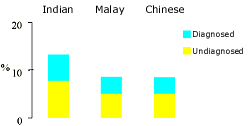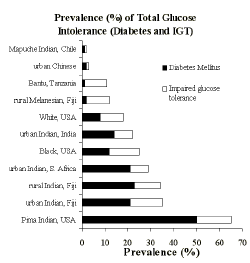Why
Diabetes?
 |
With the rapidly increasing
aging population and socio-economic changes, diabetes is becoming a formidable
public health problem in India and in the world at large. |
Many epidemiological studies demonstrated that people of Indian
origin are more susceptible to diabetes than other populations. For example,
a study in diabetes in Singapore (Diabetes Care 22:241, 1999) (Figure 1) demonstrated
that there is a two-fold increase of diabetes among Indians in comparison with
Malays and Chinese. The life expectancy in India may reach the same level as
Singapore by 2025 based on the current trend. Assuming a lower prevalence among
Indians settled in rural areas >10% prevalence among all Indians could be
predicted. Similar or higher prevalence has been reported among people of Indian
origin in other countries such as South Africa. It is therefore, likely that
among 1 billion Indians, ~ 150 million will be diabetic which will constitute
the largest group of diabetic people in the world. In addition, it is likely
that even a higher number of people have "impaired fasting glucose"
and "impaired glucose tolerance," both which also may contribute to
vascular complications. The vast majority of these people remain undiagnosed
until they develop a serious complication such as heart attack, kidney failure,
other vascular diseases resulting in amputation of limbs, blindness, debilitating
neuropathy, and kidney failure.
Early diagnosis and effective treatment
can prevent or delay many of these complications. Life-style changes (e.g.
exercise and diet) and other measures can prevent diabetes in many people.
Education of physicians, paramedical staff, and the population at large
can play a key role in preventing many debilitating complications, thus
preserving the quality of life of vast populations. Such measures will
also help reduce the enormous financial burden that society will have
to bear if attempts to treat rather than prevent diabetic complications. |
 |
Research in to the cause of the increased prevalence
of diabetes among Indians has the potential to not only improve
the quality of life of Indians but also the people in the world
at large. It is highly likely that such research could be facilitated
by a non-profit organization such as the World-India Diabetes
Foundation.
The gathering at Rochester meeting recognized the need to establish
a foundation to promote research and education on diabetes in
India. The ultimate goal of the foundation is to cure people who
have diabetes and to prevent the development of diabetes in those
who do not have it. In addition, the Foundation will support the
establishment of the state-of-the-art academic centers of excellence
to treat diabetes.


